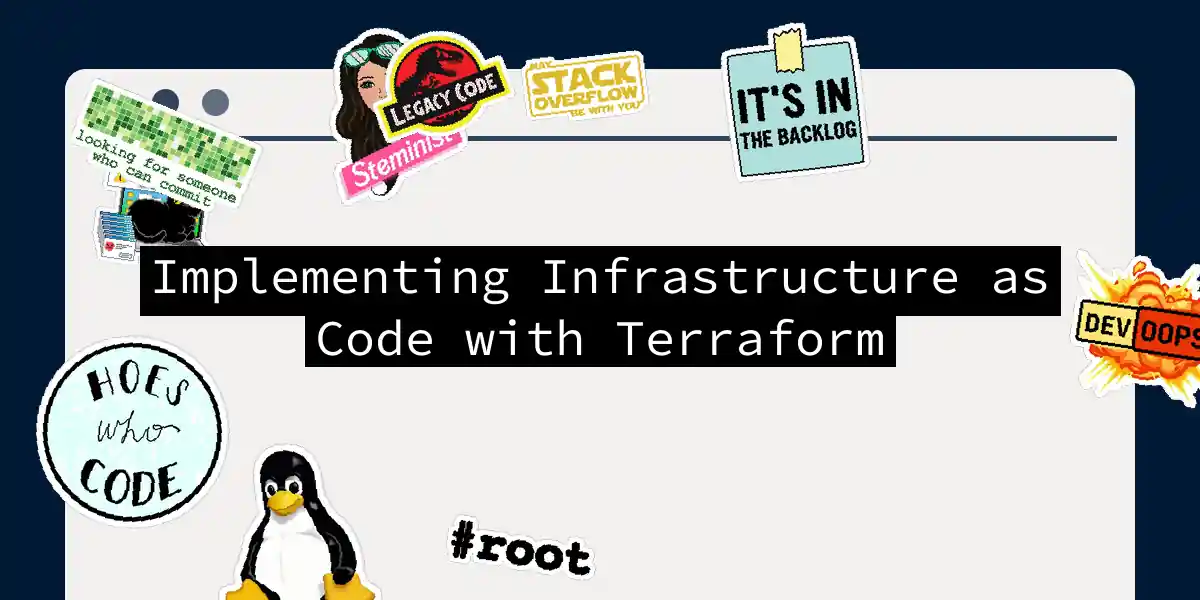What is Infrastructure as Code (IaC)?
In the ever-evolving landscape of software development and DevOps, managing infrastructure has become a critical component of the development lifecycle. Traditional methods of manually configuring and managing infrastructure are not only time-consuming but also prone to errors. This is where Infrastructure as Code (IaC) comes into play, and Terraform is one of the leading tools in this domain.
IaC treats infrastructure configuration as code, allowing you to define, configure, and manage your infrastructure through version-controlled files. This approach aligns infrastructure management with software development best practices, driving efficiency, reliability, and consistency in your cloud environments.
Why Terraform?
Terraform, developed by HashiCorp, is a powerful IaC tool that stands out for its versatility and ease of use. Here are some key reasons why Terraform is the go-to choice for many engineers:
Provider Agnostic
Terraform supports a wide range of cloud providers, including AWS, Azure, Google Cloud Platform (GCP), Oracle Cloud Infrastructure (OCI), and many more. This means you can manage a multi-cloud environment with a consistent set of tools and processes, without changing the language or syntax.
Declarative Configuration
Terraform uses the HashiCorp Configuration Language (HCL), a declarative language that allows you to specify the desired state of your infrastructure. This is in contrast to procedural languages that require step-by-step instructions. With HCL, you define what you want, and Terraform figures out how to get there.
Modularity and Reusability
Terraform modules are self-contained packages of Terraform configurations that can be reused across multiple projects. This promotes code reuse, reduces duplication, and enhances the maintainability of your infrastructure code. Modules can be shared and used by other teams, standardizing configurations across your organization.
Core Concepts of Terraform
Configuration Files
The heart of Terraform operations are its configuration files, typically with a .tf extension. These files describe the infrastructure resources required for your application and specify how to configure them. Here’s an example of a simple Terraform configuration file:
provider "aws" {
region = "us-east-1"
}
resource "aws_instance" "example" {
ami = "ami-0c94855ba95c71c99"
instance_type = "t2.micro"
}
This example initializes the AWS provider and defines an AWS instance resource.
Plan and Apply Lifecycle
The plan and apply commands are fundamental to Terraform’s workflow.
- Plan: The
terraform plancommand generates an execution plan, showing what actions Terraform will take to achieve the desired state. This provides a preview of the changes, allowing you to validate and review them before applying. - Apply: The
terraform applycommand executes the planned changes, provisioning or modifying the infrastructure resources according to the configuration files.
State Management
Terraform tracks the state of your infrastructure in a state file. This file acts as a source of truth for your environment, allowing Terraform to determine the changes needed to match your configuration. Managing this state file is crucial, especially in collaborative environments, to avoid conflicts and ensure consistency.
Benefits of Using Terraform
Automation and Efficiency
Terraform automates the provisioning of your infrastructure, reducing manual efforts and speeding up deployment cycles. This allows organizations to focus on strategic initiatives rather than mundane tasks.
Consistency and Compliance
IaC with Terraform ensures that every deployment is consistent and adheres to compliance standards. This mitigates the risk of configuration drift and non-compliance, making your infrastructure more reliable and secure.
Scalability and Flexibility
Terraform’s ability to manage infrastructure across multiple cloud providers offers unparalleled scalability and flexibility. This allows businesses to adapt swiftly to changing needs and scale their infrastructure as required.
Example: Deploying a Kubernetes Cluster with Terraform
Here’s an example of how you can use Terraform to deploy a Kubernetes cluster on Azure:
provider "azurerm" {
version = "2.34.0"
features {}
}
resource "azurerm_resource_group" "example" {
name = "example-resources"
location = "West Europe"
}
resource "azurerm_kubernetes_cluster" "example" {
name = "example-aks"
location = azurerm_resource_group.example.location
resource_group_name = azurerm_resource_group.example.name
dns_prefix = "example-aks"
default_node_pool {
name = "default"
node_count = 1
vm_size = "Standard_DS2_v2"
}
identity {
type = "SystemAssigned"
}
}
This configuration initializes the Azure provider, creates a resource group, and deploys a Kubernetes cluster within that group.
Integrating Terraform with CI/CD and Version Control
Terraform integrates seamlessly with Continuous Integration/Continuous Deployment (CI/CD) workflows and version control systems (VCS) like GitHub, GitLab, and others. This allows you to manage changes to your infrastructure through version control, just as you would with application code.
Here’s how you can automate infrastructure deployments through existing CI/CD workflows:
Security and Compliance
Terraform allows you to enforce policy guardrails using Sentinel, a policy-as-code framework. This ensures that your infrastructure deployments comply with security, compliance, and cost management policies before they are applied.
Additionally, you can use HashiCorp Vault to automate the usage of dynamically generated secrets and credentials within Terraform configurations, avoiding the need to manage static, long-lived secrets.
Conclusion
Implementing Infrastructure as Code with Terraform is a game-changer for any organization looking to streamline their infrastructure management. With its declarative configuration language, provider-agnostic nature, and robust state management, Terraform makes it easy to automate, scale, and manage your infrastructure efficiently.
As you embark on this journey, remember that IaC is not just about writing code; it’s about creating a culture of consistency, reliability, and collaboration within your team. So, go ahead, give Terraform a try, and watch your infrastructure management transform into a well-oiled machine.
And as the saying goes, “Code is king,” but with Terraform, your infrastructure becomes the kingdom.
